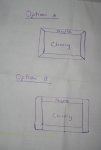Dawson Mossman
Member
- Messages
- 95
I'm building a coffee table and the top will be made of cherry with a maple border. I'm wondering if I should mitre the maple border or use square cuts and butt them up.
Option A or Option B in the attached picture is the question? What do you guys think?
Option A or Option B in the attached picture is the question? What do you guys think?


